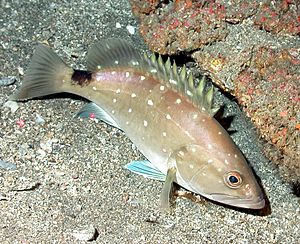Snowy grouper facts for kids
Quick facts for kids Snowy grouper |
|
|---|---|
 |
|
| Conservation status | |
| Scientific classification | |
| Synonyms | |
|
The snowy grouper (Hyporthodus niveatus) is a type of fish that lives in the ocean. It's a kind of grouper, which belongs to a larger fish family called Serranidae. This family also includes fish like anthias and sea basses. You can find snowy groupers in the western part of the Atlantic Ocean.
Contents
What Does the Snowy Grouper Look Like?
The snowy grouper has a strong, oval-shaped body. It is deepest near its dorsal fin. Its body length is about 2.4 to 2.8 times longer than its depth.
The edge of its cheek plate (preopercle) is jagged. There is often a small spine there, covered by skin. The top edge of its gill cover is curved outwards.
Fins and Colors
This fish has 11 spines and 13 to 15 soft rays in its dorsal fin (top fin). Its anal fin (bottom fin near the tail) has 3 spines and 9 soft rays. The parts between the dorsal fin spines have deep dips.
Young snowy groupers have a rounded caudal fin (tail fin). Adult fish have a straight or slightly curved tail fin.
The main color of the snowy grouper is dark brown. The spiny part of its dorsal fin has a black edge. Young fish are dark brown with clear white spots. These spots are in rows on their head and body. They also extend onto the dorsal fin.
The tail and pectoral fins (side fins) are yellow or clear. There is a dark, saddle-shaped mark on the upper part of the tail fin base. This mark goes below the lateral line (a sensory line along the fish's side).
Size of the Snowy Grouper
Snowy groupers can grow up to about 122 centimeters (48 inches) long. However, they are usually around 60 centimeters (24 inches). The heaviest recorded snowy grouper weighed about 30 kilograms (66 pounds).
Where Do Snowy Groupers Live?
The snowy grouper lives in the western Atlantic Ocean. You can find them around Bermuda and along the eastern coast of the United States. Their range goes from Virginia south into the Gulf of Mexico and the Caribbean Sea.
They also live along the coasts of Central America and South America. Their range extends from Mexico down to the Valdes Peninsula in Argentina. Sometimes, they are seen as far north as Massachusetts.
Habitat and Life Cycle
Snowy groupers live in offshore waters. They prefer rocky areas at depths between 10 and 525 meters (33 to 1,722 feet). They are most common between 100 and 200 meters (328 to 656 feet) deep.
Young snowy groupers live in shallower, coastal waters. They are often found along the northeastern coast of the United States.
What Do Snowy Groupers Eat?
Like most groupers, snowy groupers are predators. This means they hunt and eat other animals. Adult snowy groupers eat other fish. They also eat snails (gastropods), squid and octopuses (cephalopods), and crabs.
Reproduction
Snowy groupers are special because they are "protogynous hermaphrodites." This means they are born female and can change into males later in life. They gather in groups to lay their eggs, which is called spawning.
Female snowy groupers become ready to reproduce when they are 3 to 5 years old. At this age, they are about 45.1 to 57.5 centimeters (17.7 to 22.6 inches) long. They change into males about 3 to 4 years after they become mature females.
Off North America, snowy groupers spawn from May to June. A single female can lay more than 2 million eggs in one spawning season!
How Are Snowy Groupers Used?
Snowy groupers are caught by people for food. Commercial fishing boats catch them in the United States, Central America, and South America. They use different methods like hook-and-line fishing, longlines (long fishing lines with many hooks), traps, and trawls (large nets).
In U.S. waters, people can fish for snowy groupers from January 1 to August 31. However, there is a yearly limit on how many can be caught. If this limit is reached, the fishing season might close early. For example, in 2019, the fishing season closed on August 3.
See also
 In Spanish: Epinephelus niveatus para niños
In Spanish: Epinephelus niveatus para niños


